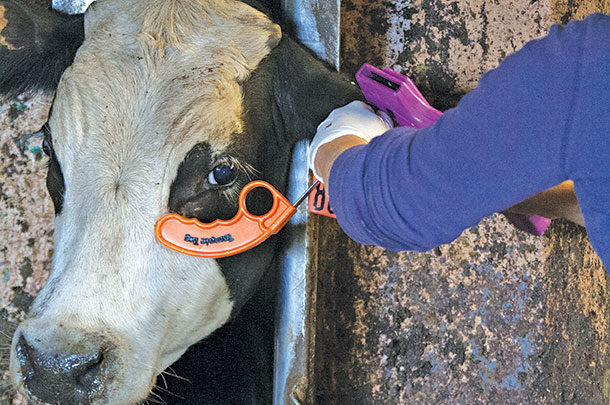Steroidal implants, often referred to as simply implants, have been used in beef cattle for more than 60 years. In addition, there are a wide array of available implants on the market. If my last count is accurate, 29 different implants are available on the market today.
Every implant on the market is approved by the FDA and labeled to “increase weight gain and improve feed efficiency” via a slow release of steroids, or synthetic steroids, over the life of that implant (often called the implant “payout”). The improvements on gain and feed efficiency when using steroidal implants in beef cattle make them effective tools to increase net profitability in our industry.
One of the first questions producers interested in improving their net profitability with implants generally ask is: “Which implant should I use?” The very “university” answer is: It depends.
 Photo courtesy of PA Beef Producers Working Group.
Photo courtesy of PA Beef Producers Working Group.
There are many factors that affect the implant one might choose. Some of those include:
a Sex of the animal: There are different implants for males and females and some that can be used on either sex.
b Weight of the animal: Some implants are best used for lighter calves, other implants are best used for heavier animals.
c Daily diet: One manufacturer now makes an implant specifically for grass-finished cattle; other implants are labeled for suckling calves and most are specific to cattle finished on grain.
Starting small
Even though selection of appropriate implants depends on the factors above, and several others, there are some good guidelines to follow. Thus, my general approach and recommendation when selecting implants for feeders is to start with less potent implants and move to greater potency through finish. Implants used for feeders have varied ranges in a wide range in “potency.”
The potency of the implant is determined by a combination of the drug it delivers and the concentration of that compound. In general, compounds used in implants may include: estradiol, zeranol, progesterone, testosterone and trenbolone acetate (or TBA). Some of these compounds may be used in combination with one another, or on their own. Specific drugs or combinations of drugs are unique to specific implants and brands of implants.
In addition to their potency, many implants are labeled with specific “payout” ranges. Most commercial implants pay out for about 100 to 120 days. Meaning, the implant will last for 100 to 120 days and then another implant will be needed. Let’s look at an example:
A group of 700-pound feeder steers entering the feedlot will be transitioned on to grain over about 21 days. Once transitioned, these steers could be given a low- to moderate-potency implant for finishing calves on grain (perhaps an estradiol-only implant or an implant that contains estradiol and a low dose, 80 milligrams, of TBA). If the steers gain 3.2 to 3.5 pounds per day, the implant payout will end around 1,000 to 1,100 pounds. Thus, another implant would be given at 1,000 to 1,100 pounds, approximately 100 to 120 days after feedlot entry.
This implant should be a stronger implant than the initial implant, perhaps with a dose of 120 milligrams of TBA, and will be the terminal implant. The terminal implant refers to that implant put in 80 to 100 days from slaughter. Many cattle managers will use a TBA implant for the terminal implant because the efficiency of steers is reduced as they reach maturity, and the TBA helps sustain lean tissue accretion in these heavier animals.
Matching programs
The example above is just one scenario. With the variety of implants available, implants can be appropriately matched to any feeder program. Cattle that are implanted have a 10 to 15 percent increase in average daily gain when compared with cattle that are nonimplanted, and an 8 to 12 percent increase in feed efficiency.
Because of the improved gain and feed efficiency, steroidal implants are probably one of the, if not the, most effective tools to increase net profitability in the beef industry. Dr. Bob Weaber of Kansas State University shared in 2011 that “A feed efficiency improvement of approximately 10 percent across the entire feedlot sector would reduce feed costs by 1.2 billion dollars.” Applying this quote to the current discussion, if the entire feedlot sector used implants, we could save $1 billion annually. And, yet, steroid implants are shrouded with controversy. Why?
Fighting perceptions
In today’s food climate, the consumer is increasingly removed from the farm. Those of us involved in agriculture know the stats by heart: Two percent of the population feeds the other 98 percent. But that 98 percent have very strong opinions about how their food is produced. The increasing consumer demand for “all natural” products puts implantable hormones at the same risk as rBST. It is difficult to go to the grocery store and find a single dairy product that is not labeled “Made with milk from cows not treated with rBST.” Likewise, the products in the meat case labeled as “hormone-free” are rapidly increasing.
Despite consumer scrutiny surrounding implant use, implanting cattle has miniscule effects on hormone concentrations in meat for human consumption. While implanting a steer may raise the estrogenic activity in a 3-ounce steak 0.6 nanograms (a nanogram is one billionth of a gram), eating the same steak from a heifer as opposed to a steer will cause consumers to increase intake of estrogenic activity by 3.8 nanograms.
Meanwhile, when compared to a serving of steak, a serving of broccoli has nearly 90,000 times the estrogenic activity, a vegetarian (black bean burger) has over 1,000,000 times the estrogenic activity and tofu has 250,000,000 times the estrogenic activity.
The moral of the story is hormones exist in every living thing: plant, animal or human. Not only does the human body have a unique ability to handle foreign compounds entering via the digestive tract, but all hormones, regardless of whether they come from plants or animals, are treated similarly in the digestive tract. Thus, one of our greatest challenges is educating consumers about the safety of meat produced from implanted cattle.
The message all beef producers need to be willing to share is technologies, like implants, are crucial to maintaining food security for a growing world population. The world will need a little more than 50 percent growth in the meat sector by 2050 to match the population’s demand for meat, and we will need technologies, like implants, to help us get there.









